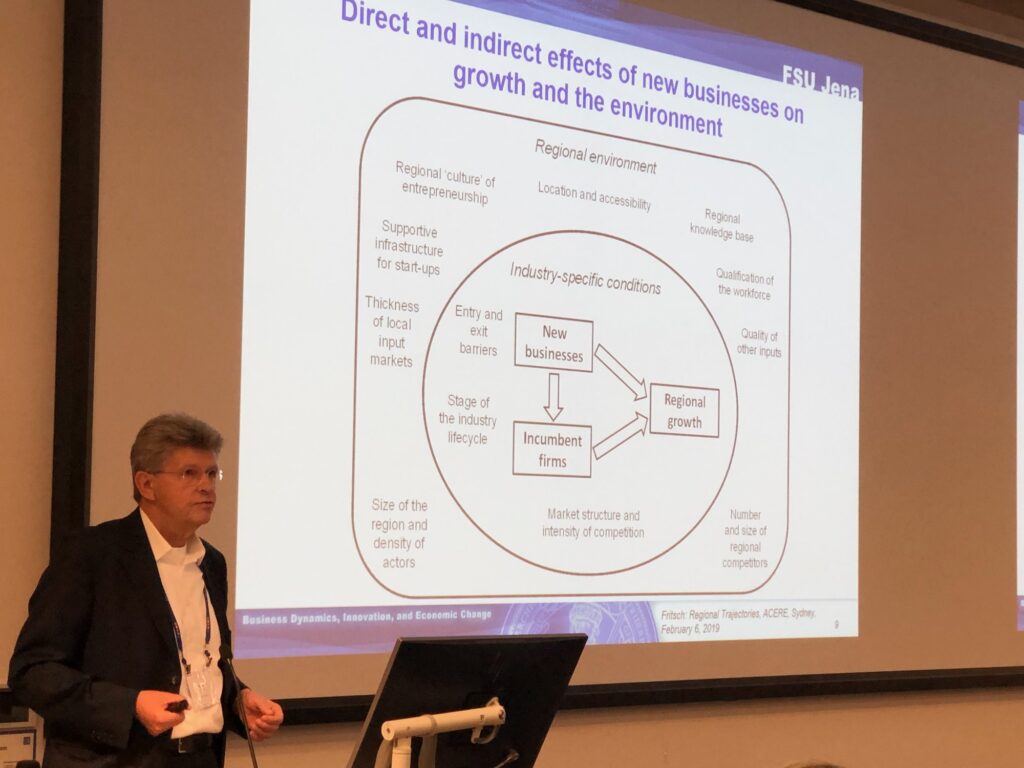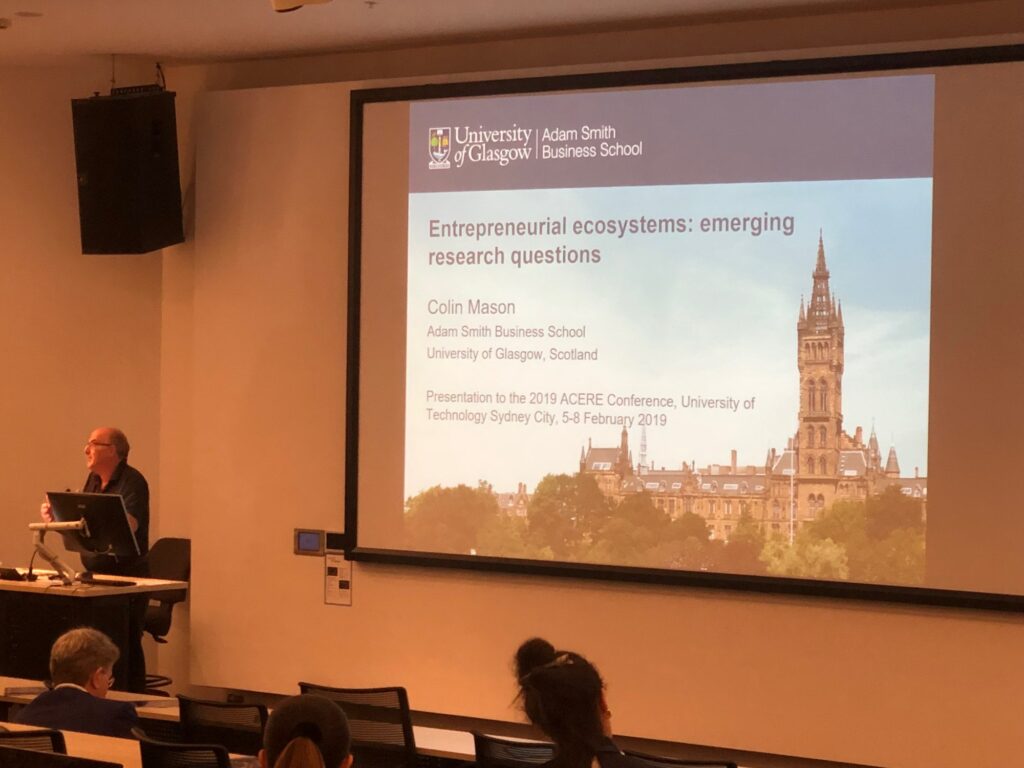Connecting practitioners with entrepreneur research – reflections on the 2019 Australian Centre for Entrepreneurship Research Exchange (ACERE)
Entrepreneur research is needed now more than ever. The impact of innovation policy may not be seen for years, long after short term election cycles. The success of entrepreneur programs and platforms can seem to be measured by presentation, personality and hashtags over economic performance.
Tax incentives are changed, innovation hubs created or removed, and governments, universities, corporations, and other investors all focus resources and budgets towards or away from innovation seemingly based on equal parts strategy and whim. These decisions have long-term impacts in a rapidly changing environment, all to support entrepreneurs where success is measured in weeks and months. Research is needed to provide greater assurance to those making these decisions and public who is impacted by them.
Do entrepreneur ecosystems create jobs? If you are an entrepreneur with a side hustle, will you have better life satisfaction than if you commit full-time? How is your future wage potential impacted by being an entrepreneur? Are female mentors disadvantaged by stereotypes? Do university accelerators improve entrepreneur outcomes? Could entrepreneur activities help eliminate poverty in western society?
These are just some of the questions explored at the recent 2019 Australian Centre for Entrepreneurship Research Exchange (ACERE). The conference program saw over 137 researchers from 19 countries come together in Sydney to review over 106 submissions on emerging research in the field of entrepreneurship.
The conference format is different from the wave of startup events such as Startcon, Qode, SouthStart, West Tech Fest, and Pausefest. Rather than panels of startup founders or technology company executives, the presenters are researchers presenting initial findings and approaches, who then receive feedback and comments from a room full of international research leaders and peers. The three days are a combination of paper presentations and table workshops on topics related to entrepreneurial studies, top and tailed with key notes from leaders in entrepreneurial research.
Emerging research focus areas
The conference is a sample of emerging entrepreneur research – identifying perhaps where the challenge points are in the sector and emerging needs for policy.
Where are we placing our focus? If the collective body of research were to reflect future input into policy and programs, where could we expect to see change? How could each body of research make a substantial difference in how entrepreneurs build, grow, and scale their business?
To give an idea for those who were not in the room, I examined titles and abstracts of the 106 submissions to look for patterns and themes. For each submission, I asked the question…
- What is the primary focus of the submission? Where is the primary focus of the research – the system (the ecosystem, system origins, quality, etc.), the entrepreneur (characteristics, decision making, quality, etc.), the firm (startup, SME, micro-business, home-based business, etc.), or the support actor (finance, university, accelerator, space, etc.).
- What are the functions or features that are explored? What is the focus of the research – regional, social impact, technology, industry sector, psychology. Each of these can have further sub-areas, such as manufacturing or medtech, poverty or gender, early-stage business or business exits)
- What approach did the researcher take? How the research is carried out, qualitative or quantitative, sample size, who is studied, theoretic underpinnings, methodology, research geographic location, etc.
This approach produced over 90 codes or categories, a small sample of which were applied to the BxToolBox Venn diagram engine to help visualise size and overlap. A Venn diagram for this purpose is not entirely accurate as not all relationships are represented due to limitations of the format and multiple cross-over of concepts. It does however provide an indication of weighting and some idea of crossover.

This is more of a thought experiment than a body of research. A few caveats and limitations are needed before drawing conclusions:
- This is subjective and not an in-depth analysis.
- It is limited to the abstract or in some cases just the title. The coding is based on what was perceived as the main emphasis of the research, but this may be different based on the full paper submission.
- The sample is based on submissions at the ACERE conference, and may not be reflective of all emerging research. It does provide an indication of a sample body of research submissions that was not constrained by a theme or topic.
With this in mind, some observations below:
The founder is a focus: A dominant number of submissions focused on the entrepreneur (62), followed by those centered on the firm (29), support actors (26), and the underlying system (25). There was some cross-over, but the expected focus of an entrepreneur ecosystem is the founder.
Entrepreneur research is complex: There is significant diversity in the research areas and specific focus in each. For example, a number of papers explored topics related to financial capital (9), which included topics about microfinance, social finance and crowdsourcing, financial intermediaries, initial coin offerings, and angel investing. Submissions examined different sectors including manufacturing (3), creative industries (4), agriculture, medtech, biotech, hardware, and ICT or digital firms in general (9). There is a seemingly endless number of areas to explore in entrepreneur research, not to mention combinations of different areas.
Entrepreneurship to improve the person and change the world: Social impact areas were also represented with at least eleven submissions relating to topics on poverty, altruism, social enterprise, diversity, and wage equality. Related submissions included papers on segments of community including indigenous (3), gender and primarily female entrepreneurship (9), and non-metro or regional areas (3). Some papers explicitly focused on stages of the firm as new or early stage (11) or the closure, sale, failure, spinoff, or otherwise exit of the firm (3). Papers also focused on some characteristic relating to psychology of the entrepreneur or team (18) and a particular focus on well-being, mental health, or lifestyle satisfaction (12). Entrepreneurship has a clear social and psychological impact beyond the economic value to an individual or region.
Keynote take away – it’s a long game and more work needs to be done

Photo: Professor Michael Fritsch from Friedrich Schiller University Jena in Germany
The submissions were supported with keynotes from international renowned researchers. The opening keynote was Professor Michael Fritsch from Friedrich Schiller University Jena in Germany.
A few of the key messages from his presentation included:
- It takes time: The positive effect of new business formation on regional growth evolves over a long period of time, often in excess of ten years. This can be a challenge for leaders with short term performance incentives, as the impact from new business activity can actually have a negative impact in the short term of the initial five years.
- We need quality as well as quantity: High levels of entrepreneurship and entrepreneur activity alone are not related to regional economic growth. Regions can have high number of entrepreneur activity but still have a negative economic impact. The quality of the entrepreneur plays a key role.
- It is about the existing businesses as much as new entrepreneurs: New entrepreneurs and new business models can be seen as a threat to incumbents. Indeed, new technology can be seen to remove jobs. However, research demonstrates that the direct value from new entrepreneurs on a region is less than the indirect effects on existing businesses in the region. The impact on established incumbent businesses comes from areas such as improving to better compete and growth in local supply chains that support new business models. Again, this can occur over a longer period of time, in excess of ten years.
- Entrepreneurship is persistent and difficult to change: Regional levels of entrepreneurship are persistent, meaning that historically high or low levels of entrepreneurship are likely to remain over generations. Explanations include the presence of a single actor that constrains resources for new entrants, generational entrepreneurship, and informal institutions and a culture that is resistant to other market shocks.
If entrepreneurship is persistent in a region and it can take up to a decade to see change, then those supporting entrepreneurial activity need to take a strategic and long view. This may be contrary to short-term election cycles, grant funding rounds, or corporate investment appetites. Focus needs to be on both fostering entrepreneurs to diversify the economy while also leveraging key assets to focus on strengths in the region.

Photo: Professor Colin Mason from the University of Glasgow
Another keynote was that of Professor Colin Mason from the University of Glasgow. Colin identified five key areas for future research:
- Ecosystem creation: How entrepreneur ecosystems are created, who is involved, and what contributes to their sustainability
- Ecosystems over time: The role of time in entrepreneur ecosystems, how they evolve, rise, and decline, what contributes towards ecosystem resilience
- Ecosystem actors and relationships: The domains of an entrepreneur ecosystem, roles of specific actors, how they are related, and networks created
- Firms in ecosystems: How firms do or do not interact with entrepreneur ecosystem support services
- Regional ecosystems: Small town entrepreneur ecosystem, and how they survive or thrive with scarce resources and lower density
Innovation ecosystems are rapidly changing and what works in one environment may not work in another. There has been significant research into the field but more is needed.
Next steps – connecting research and practitioners
Research plays a key role in informing policy and providing confidence that decisions are supported by experience. The complexity from diverse fields, changing environments, and differences in regions mean that the field will continue to expand even as we continue to build on past research. To do this more rapidly, we need to continue to connect researchers with practitioners to both perform studies and deliver outcomes.
Managers and leaders are doing exceptional work with available information in local government, innovation hubs, accelerator programs, universities, high schools, service providers, investment, and entrepreneurs themselves. These leaders are often time poor, making decisions on instinct or past experience with limited resources.
During networking functions at the conference, I connected researchers with practitioners. Researchers using wearables to monitor entrepreneur well-being were connected to program leaders focused on entrepreneur performance. Researchers examining perspectives of an entrepreneur connected to providers in virtual reality to explore development of simulations.
How could this be done more effectively? Could a practitioner in an entrepreneur project focusing on women in regional areas such as the WiRE program better connect with researchers relating to that field? Could a project that teaches prisoners to code connect with researchers focusing on the role of entrepreneurship in supporting marginalised segments of society?
One source is the Startup Status maps that could identify potential collaboration partners. At any given time, there are researchers and practitioners addressing challenges that focus on:
- regions (eg., Sunshine Coast, Sydney, Western Australia),
- community segments with programs designed for female entrepreneurs or indigenous entrepreneurs,
- industries or technologies such as agriculture, hardware, or creative industries, or
- primary roles such as government or university.
One challenge can often be in just knowing who is operating in the field of study. The map is early in development and a continuous work in progress. New contributions are added weekly. Feedback, additions, and corrections are welcome.
The conference connected researchers from around the world to share information and outcomes. It is through these connections that we can improve the research and better connect research with impact. This post has been intended to extend that result in a small way. Please feel free to connect and comment to engage with others interested in similar outcomes.

